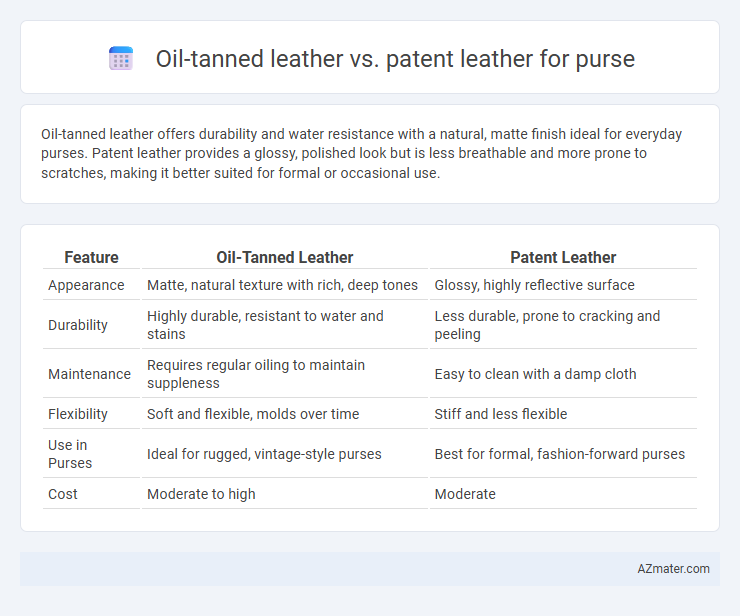Oil-tanned leather offers durability and water resistance with a natural, matte finish ideal for everyday purses. Patent leather provides a glossy, polished look but is less breathable and more prone to scratches, making it better suited for formal or occasional use.
Table of Comparison
| Feature | Oil-Tanned Leather | Patent Leather |
|---|---|---|
| Appearance | Matte, natural texture with rich, deep tones | Glossy, highly reflective surface |
| Durability | Highly durable, resistant to water and stains | Less durable, prone to cracking and peeling |
| Maintenance | Requires regular oiling to maintain suppleness | Easy to clean with a damp cloth |
| Flexibility | Soft and flexible, molds over time | Stiff and less flexible |
| Use in Purses | Ideal for rugged, vintage-style purses | Best for formal, fashion-forward purses |
| Cost | Moderate to high | Moderate |
Introduction to Oil-Tanned and Patent Leather
Oil-tanned leather is known for its durability and natural water resistance due to the infusion of oils during the tanning process, making it ideal for purses that require a rugged yet supple texture. Patent leather features a high-gloss finish achieved through a coating of lacquer or synthetic substances, providing a sleek, shiny appearance favored for formal and stylish handbags. Both materials offer distinct aesthetic and functional qualities, with oil-tanned leather emphasizing toughness and longevity while patent leather prioritizes elegance and visual impact.
What is Oil-Tanned Leather?
Oil-tanned leather is treated with natural oils and waxes during the tanning process, enhancing its durability and water resistance while maintaining a soft, supple texture. This type of leather develops a rich patina over time, making it ideal for purses that age gracefully with use. Compared to patent leather, which has a shiny, coated finish, oil-tanned leather offers a more natural look and superior flexibility for everyday wear.
What is Patent Leather?
Patent leather is a type of coated leather known for its glossy, high-shine finish achieved through a plastic or lacquer coating. This coating creates a smooth, reflective surface that is resistant to water and dirt, making it ideal for stylish and formal purses. Unlike oil-tanned leather, which is characterized by a matte, durable finish with natural textures, patent leather offers a sleek, polished appearance but requires careful maintenance to prevent scuffs and cracking.
Key Differences: Oil-Tanned vs. Patent Leather
Oil-tanned leather features a matte, supple finish achieved through a specialized tanning process using natural oils, making it highly durable and water-resistant, perfect for long-lasting purses. In contrast, patent leather is coated with a glossy, plastic-like finish that offers a sleek and shiny appearance but is more prone to scratches and less breathable. Key differences include oil-tanned leather's rugged texture and durability versus patent leather's high-gloss surface and reduced flexibility.
Durability and Longevity Comparison
Oil-tanned leather is highly durable and water-resistant due to its natural oils, making it ideal for purses that withstand daily wear and tear. Patent leather, while visually striking with its glossy finish, is more prone to cracking and scuffing over time, especially if exposed to extreme temperatures or moisture. For longevity, oil-tanned leather purses generally maintain their structural integrity and develop a unique patina, whereas patent leather purses require careful maintenance to preserve their shine and prevent damage.
Care and Maintenance Requirements
Oil-tanned leather demands regular conditioning with specialized oils or creams to maintain its supple texture and water resistance, and it naturally develops a patina over time enhancing its character. Patent leather, characterized by its glossy finish, requires gentle cleaning with a damp cloth and occasional use of a patent leather cleaner to prevent cracks and maintain shine. Both materials should be kept away from excessive heat and prolonged sunlight exposure to avoid damage and color fading.
Aesthetic and Style Considerations
Oil-tanned leather offers a rich, matte finish with a natural, rugged aesthetic that develops a unique patina over time, ideal for a sophisticated and timeless purse style. Patent leather boasts a glossy, reflective surface that provides a sleek, polished look, perfect for statement pieces and formal occasions. Both materials convey distinct style messages, with oil-tanned leather emphasizing durability and vintage charm while patent leather highlights modern elegance and high shine.
Water and Stain Resistance Differences
Oil-tanned leather offers superior water resistance due to its wax and oil treatments, creating a natural barrier against moisture and stains, making it ideal for everyday use. Patent leather, coated with a glossy synthetic finish, provides excellent stain resistance and easy cleaning but is less breathable and can show water spots more visibly. When choosing a purse, oil-tanned leather balances rugged durability and moisture protection, while patent leather excels in maintaining a sleek, stain-free appearance.
Ideal Uses for Oil-Tanned and Patent Leather Purses
Oil-tanned leather purses excel in durability and water resistance, making them ideal for everyday use and outdoor activities where toughness is essential. Patent leather purses offer a glossy, polished finish suited for formal events and evening wear, providing a stylish and sophisticated look. Choosing between these materials depends on whether functionality or fashion takes precedence in the purse's intended use.
Choosing the Right Leather for Your Purse
Oil-tanned leather offers durability, water resistance, and a natural, rugged texture that ages beautifully with use, making it ideal for everyday purses requiring longevity and character. Patent leather provides a high-gloss finish with a polished, formal look, perfect for dressy occasions but tends to be less breathable and more prone to scratches. Selecting the right leather depends on balancing durability, appearance, and maintenance needs tailored to your lifestyle and purse usage.

Infographic: Oil-tanned leather vs Patent leather for Purse
 azmater.com
azmater.com